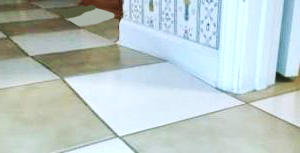Tiles, most often made of  ceramic, porcelain or natural stone, are often used in building construction to cover surfaces including floors or walls. Like most building materials they require strict installation requirements that, if not met, can cause problems as your building ages.
ceramic, porcelain or natural stone, are often used in building construction to cover surfaces including floors or walls. Like most building materials they require strict installation requirements that, if not met, can cause problems as your building ages.
Here are 5 construction error areas commonly found with tile installation:
Lack of Movement Accommodation Joints
As temperature and humidity varies, all tile will move, and therefore installation requires expansion or movement joints that eliminate stress on the tiles themselves. These allowances for expansion and contraction will help to avoid tile tenting and cracking. Movement joints are often composed of materials made of urethane, neoprene or polysulfide for traffic areas, and silicone where traffic is not a concern.
Cheap Bonding Used
Since the bonding material cannot be seen, unscrupulous installers may use cheaper bonding materials that can fail down the road. Insist on premium quality bonding materials, and check with your material manufacturer for their recommendations.
Missing Mortar Bonding Coverage
Industry standards require a minimum of 80% mortar coverage for tile installation in dry areas and 95% coverage for wet areas such as showers or exterior locations to avoid void spaces that could trap moisture and promote mold growth. If using natural stone, 95% mortar coverage is required there also. As a definition, mortar coverage refers to the contact area of the back of the tile or stone where it will come into contact with the supporting surface.
Non-Flat or Non-Rigid Surfaces
To correctly apply tile to a surface that surface must be flat, and meet standards for flatness tolerances. If surfaces are not flat, they must be corrected before the installation begins. If there are cracks in the supporting concrete, they must be treated with a crack isolation membrane. Supporting surfaces must also be rigid or stiff. If they are not, they may require an additional subflooring. This will help avoid cracked tiles over that area. Sub-surfaces for natural stone tile must be twice as thick as those for ceramic or porcelain tile.
Wrong Installation Conditions and Cure Times
Since bonding must set and cure, temperatures must be maintained with a specified range and for a specified duration, according to manufacturer guidelines. Tile must also be allowed time to cure before being exposed to traffic, moisture or temperature changes.
Always look for an experienced tile installer, who is up to date on the most current regulations for their industry.
Do You Suspect a Tile Installation Error? Call Först Consulting Group.
If you suspect a construction error with tile installation, call us. Först Consulting Group can inspect your tile, looking for these listed conditions, offer pricing ranges for remediation, and provide you will a full report as evidence against your tile installer. Rely on Först to be your construction advocate. Contact us today.




